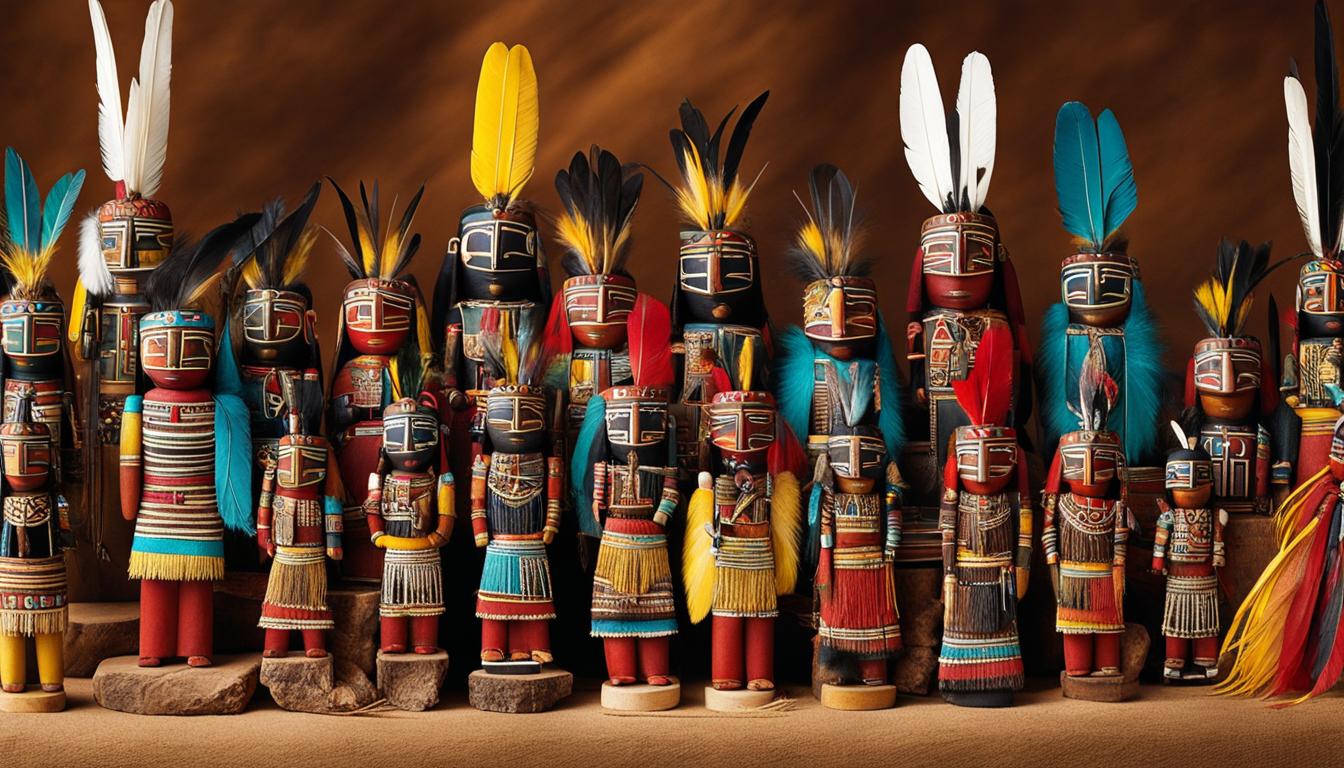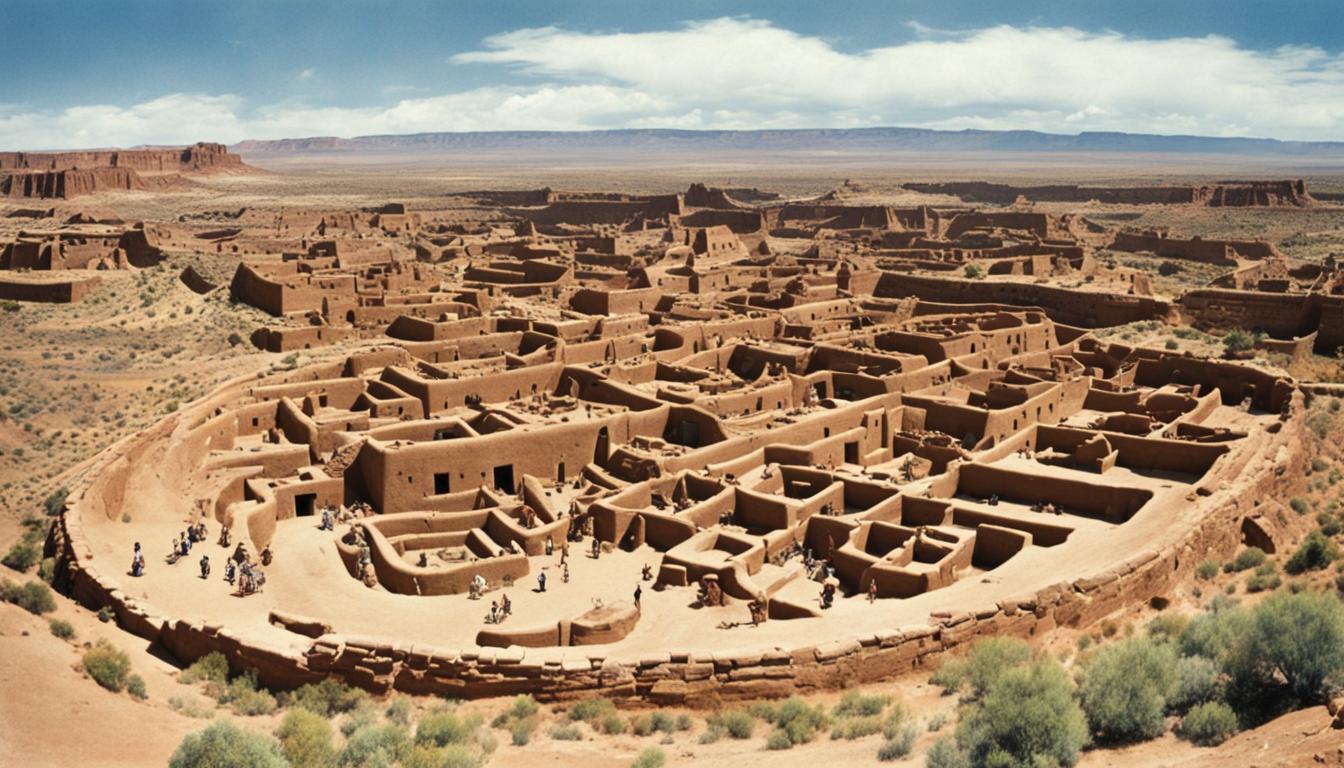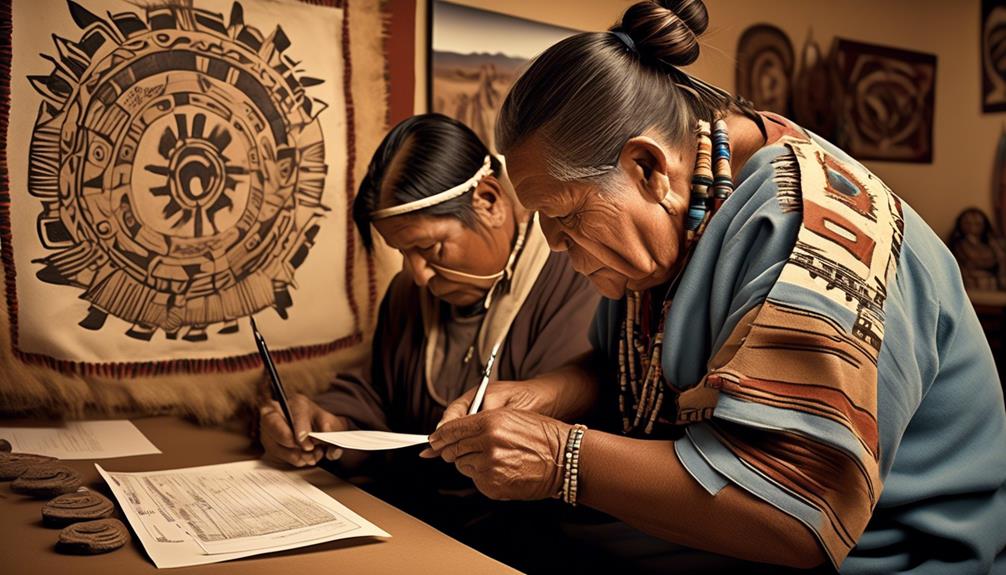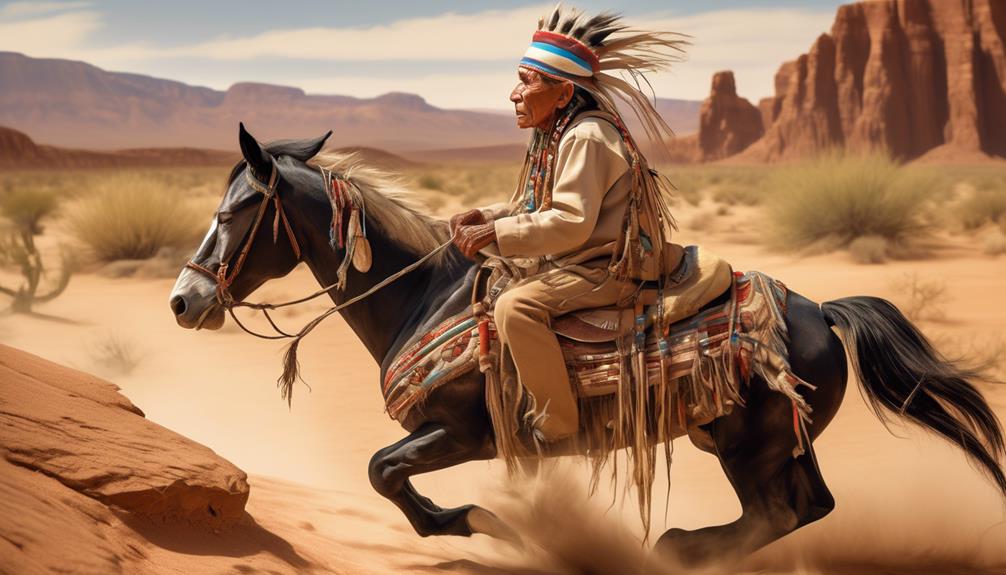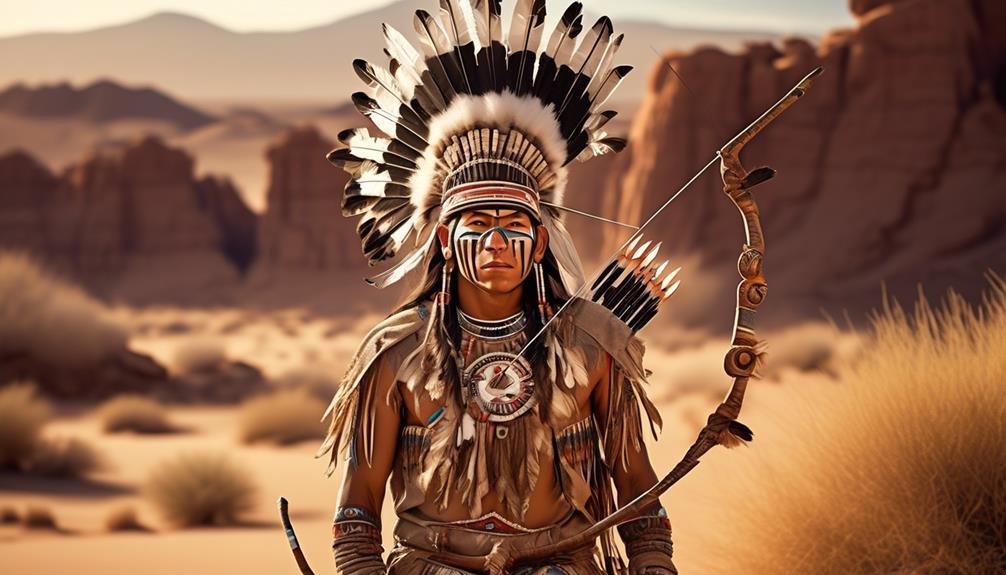Welcome to our exploration of the religious customs and rituals of the Hopi tribe, one of the oldest Native American tribes. The Hopi community is deeply rooted in spiritual beliefs and cultural practices that emphasize maintaining balance and harmony with the natural world. Their traditional religion involves a variety of rituals and ceremonies designed to honor their ancestors and connect with the spiritual realm.
In this article, we will delve into the significance of Hopi rituals, ceremonies, and spiritual beliefs, exploring how they shape the Hopi culture and way of life. From sacred rituals to the role of the Hopi Sun God, we will uncover the rich tapestry of the Hopi religious traditions.
Key Takeaways:
- The Hopi tribe’s religious practices are rooted in maintaining harmony and balance with the natural world.
- Hopi religious rituals and ceremonies are performed to honor ancestors and connect with the divine.
- The Hopi Sun God holds great significance in Hopi mythology and religious practices.
- Hopi songs, dances, and Kachina spirits play integral roles in their religious ceremonies.
- Preserving and respecting Hopi religious traditions is crucial to the preservation of their cultural identity.
Brief History of Hopi Religion
The Hopi people have a rich history and deep spiritual beliefs that have been passed down through generations. Their religious practices and beliefs are intertwined with their ancestral origins and the ceremonialism that defines their culture.
The Hopi believe that their ancestors emerged from the earth in their current land, guided by spiritual beings. This ancestral origin story is the foundation of their religious beliefs and shapes their worldview. The Hopi people hold the responsibility of maintaining balance and harmony between the earth, sky, and all living things.
Ceremonialism and traditional rituals play a central role in Hopi religious practices. These rituals are seen as a means to honor their ancestors and maintain the delicate balance in the universe. Through their ceremonies, the Hopi people express their gratitude to the divine and seek blessings for their tribe and the natural world.
One of the prominent ceremonies celebrated by the Hopi is the Hopi New Year, known as Soyalangwu. This important ceremony marks the beginning of a new agricultural cycle and is a time of purification and renewal. Another significant ceremony is the Katsina Dance, where dancers embody the spirits of the Kachinas, bringing blessings and teachings to the community.
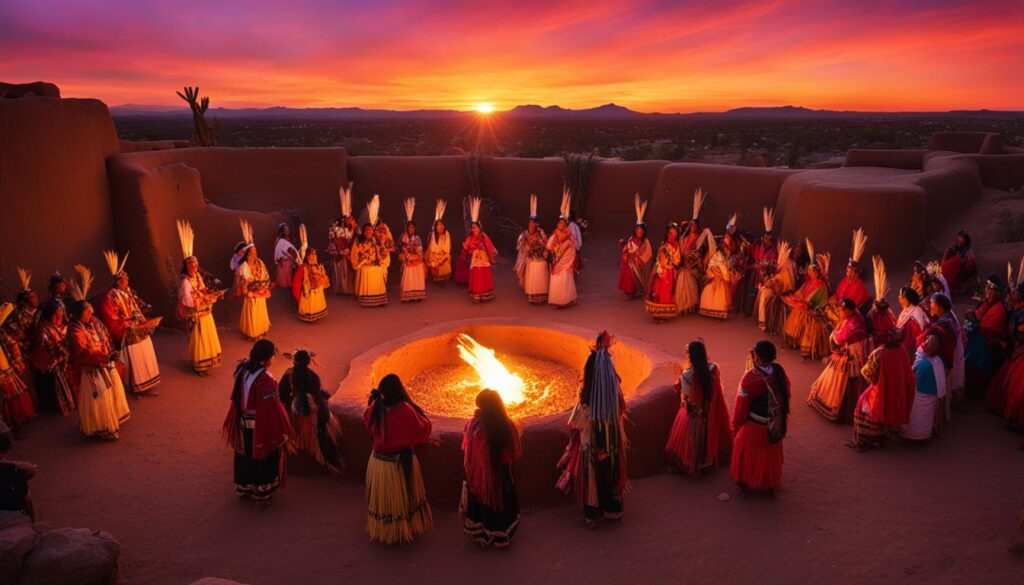
“The Hopi religion emphasizes ceremonialism and traditional rituals as a way to honor their ancestors and maintain balance and harmony.”
Through ceremonial objects, traditional songs, and dances, the Hopi people connect with their spiritual beliefs and strengthen their cultural traditions. These practices hold deep meaning and significance for the Hopi, connecting them to their heritage, ancestors, and the divine.
Despite the challenges posed by the modern world, the Hopi people remain steadfast in preserving their religious practices and way of life. Their commitment to honoring their ancestral origins, practicing ceremonialism, and partaking in traditional rituals ensures the continued vitality of Hopi spirituality and cultural traditions.
Hopi Religious Beliefs: The power of ceremonialism
The Hopi religious beliefs are rooted in the power of ceremonialism. Through ceremonial practices, the Hopi people maintain a connection with their ancestors and the spiritual world. These ceremonies serve as essential milestones in the lives of individuals and the community, marking significant events and celebrating their spiritual identity.
| Ceremony | Purpose |
|---|---|
| Hopi New Year (Soyalangwu) | Celebration of the beginning of a new agricultural cycle, purification, and renewal. |
| Katsina Dance | Embodiment of Kachina spirits, bringing blessings and teachings to the community. |
“Ceremonial practices hold deep meaning and significance for the Hopi, connecting them to their heritage, ancestors, and the divine.”
These ceremonial practices are not merely symbolic but encompass a spiritual essence. The use of ceremonial objects, traditional songs, and dances heighten the sacredness of the rituals. Each aspect of the ceremony serves a specific purpose and contributes to the overall religious experience for the Hopi people.
“The Hopi religious beliefs are rooted in the power of ceremonialism. Through ceremonial practices, the Hopi people maintain a connection with their ancestors and the spiritual world.”
The role of spiritual leaders and elders is vital in preserving the authenticity and integrity of Hopi ceremonialism. They guide the community in performing the rituals correctly, ensuring that the practices align with their cultural traditions and beliefs.
The Hopi people’s commitment to their religious practices and the sacredness of their ceremonies reflects their dedication to maintaining harmony with the natural world and living in accordance with their ancestral teachings. These practices continue to be a cornerstone of Hopi identity, spirituality, and cultural traditions.
Overview of Hopi Religious Ceremonies
Hopi religious ceremonies are a cornerstone of their spiritual and social lives, deeply rooted in their cultural heritage. These ceremonies serve as a way for the Hopi people to connect with their ancestors, honor the natural world, and maintain harmony within their community.
Kachina Ceremony: Embodying the Divine
One of the most significant Hopi religious ceremonies is the Kachina ceremony. During this ceremony, dancers embody the spirits of the Kachinas, who are revered as divine messengers. The dancers wear elaborate costumes and masks, representing specific Kachina spirits, and perform intricate dances that have been passed down through generations. The Kachina ceremony is believed to bring blessings and guidance to the Hopi people.
Rites of Passage
Hopi religious ceremonies also encompass various rites of passage, marking important milestones in an individual’s life. These ceremonies include naming ceremonies, puberty rites, and marriage ceremonies. Each rite of passage is celebrated with specific rituals and songs, symbolizing the transition from one stage of life to another. These ceremonies not only honor the individual but also strengthen the connection between the individual and the Hopi community.
Hopi Songs and Dances: Preserving Cultural Heritage
Hopi songs and dances hold deep spiritual significance and play a crucial role in Hopi religious ceremonies. Each song and dance has its own meaning and purpose, showcasing the relationship between the Hopi people and the natural world. The songs and dances are passed down through generations, ensuring the preservation of Hopi cultural traditions and the transmission of their spiritual beliefs. Through these expressions, the Hopi people continue to connect with their ancestors and maintain their cultural identity.
Guidance from Spiritual Leaders and Elders
Hopi religious ceremonies are conducted and overseen by spiritual leaders and elders who possess deep knowledge and understanding of Hopi traditions. They ensure the authenticity of the ceremonies and guide the community in maintaining the spiritual integrity of the Hopi culture. The wisdom and guidance of these leaders are essential in upholding the values and teachings embedded in the religious ceremonies.
In conclusion, Hopi religious ceremonies are a vibrant reflection of the Hopi people’s spiritual beliefs, cultural traditions, and connection to the natural world. The Kachina ceremony, rites of passage ceremonies, Hopi songs and dances, and the guidance of spiritual leaders and elders all contribute to the richness and significance of Hopi religious practices. These ceremonies not only honor the past but also provide a strong foundation for the present and future of the Hopi community.
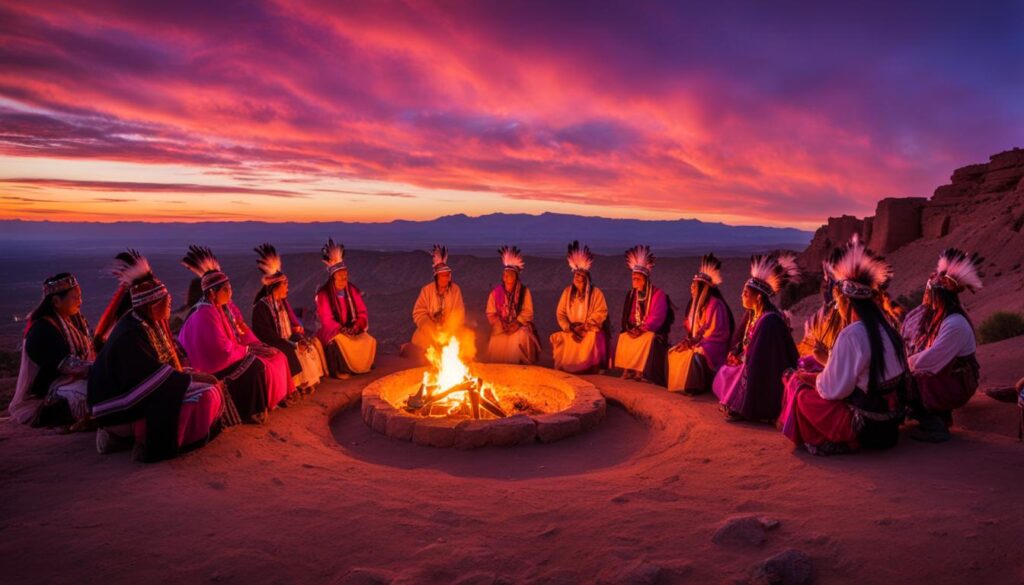
Significance of Kachinas in Hopi Spirituality
Kachinas, the spiritual messengers in Hopi mythology, play a vital role in connecting the Hopi people to their ancestors and the spiritual world. These sacred beings are believed to bring essential elements such as rain, fertility, and protection to the Hopi community, ensuring harmony and balance in the universe.
Within Hopi religious ceremonies, Kachinas are impersonated by dancers who embody their unique characteristics and traits. Each Kachina figure represents a specific aspect of the natural world, such as animals, plants, and ancestral spirits, embodying their essence during the ceremonies.
The reverence for Kachinas runs deep within Hopi culture, as they are considered bridges with the divine and serve as intermediaries between the Hopi people and the spiritual realms. Disrespectful use of Kachina figures is seen as a violation of Hopi religious principles, emphasizing the sanctity and importance of these sacred beings.
“The Kachinas are the essence of our spiritual beliefs and cultural traditions. They are the embodiment of our connection to our ancestors and the spiritual world that guides us.” – Hopi Elder
The significance of Kachinas in Hopi spirituality cannot be overstated. Their presence serves as a reminder of the Hopi people’s deep-rooted connection to their ancestral spirits and their commitment to maintaining the harmony and spiritual integrity of their culture through religious ceremonies.
| Kachina Figure | Represented Aspect |
|---|---|
| Sahkimi | Corn Maiden and symbol of fertility |
| Hemis Kachina | Representative of the winter solstice |
| Badger Kachina | Guardian of the earth and its resources |
| Kwahu Kachina | Sun Priest and bringer of summer rains |
These are just a few examples of the diverse Kachina figures found in Hopi spirituality. Each Kachina holds a unique purpose and meaning within the religious ceremonies, further enriching the cultural tapestry of the Hopi people.
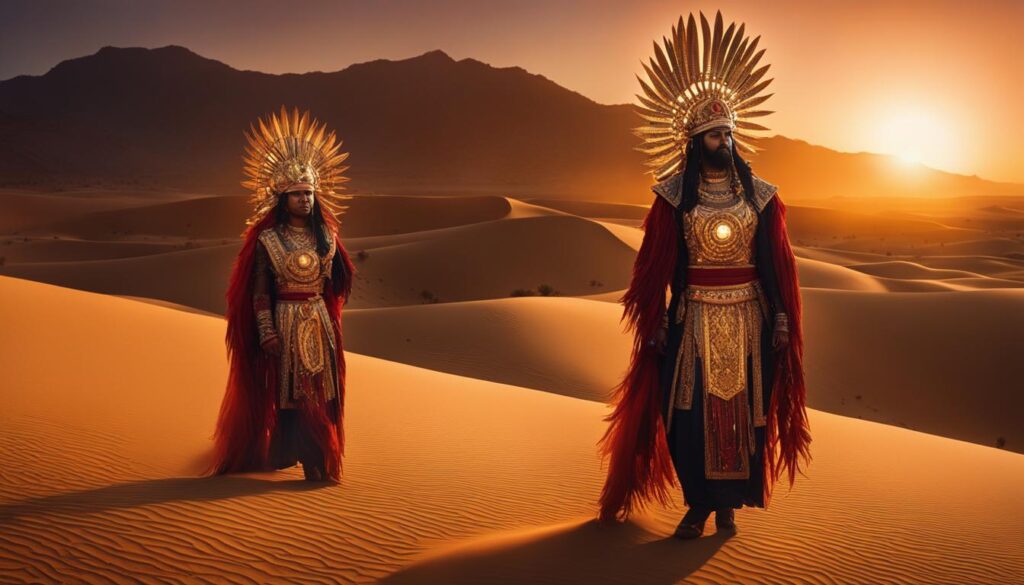
Importance of the Hopi Sun God
“Tawa, the Sun God, is the embodiment of our beliefs and the foundation of our spiritual practices.”
The Hopi people deeply honor Tawa, seeing the Sun God as the embodiment of their cultural beliefs and the foundation of their spiritual practices. Tawa’s presence can be felt in every aspect of Hopi culture, from their religious ceremonies to their daily lives. The Sun God represents the source of life, providing sustenance, warmth, and light to all living beings.
Tawa’s teachings serve as a guiding light for the Hopi people, offering wisdom and insight into the interconnectedness of all things. The Hopi creation stories depict Tawa as the creator of the First World, shaping the landscape and instilling order and harmony. The Hopi people believe that by following Tawa’s teachings and prophecies, they can maintain balance and live in accordance with the natural order.
The Role of Tawa in Hopi Religious Ceremonies
Tawa’s influence is evident in Hopi religious ceremonies, where the Sun God is revered and honored. These ceremonies serve as a means to express gratitude, seek blessings, and seek guidance from Tawa. During these rituals, participants offer prayers and perform dances to connect with the divine energy of the Sun God and receive spiritual blessings.
One of the most significant ceremonies is the Hopi Snake Dance, dedicated to Tawa and performed to ensure the balance between the Hopi people and their surroundings. The dancers, representing the spiritual power of the Sun God, perform intricate movements to demonstrate their reverence and invoke Tawa’s presence.
Major Hopi Religious Ceremonies
| Ceremony | Description |
|---|---|
| Katsina Dance | A celebration of the Katsina spirits, who bring blessings and guidance to the Hopi people. |
| Soyal Ceremony | The Hopi New Year celebration, welcoming the return of the Katsina spirits. |
| Bean Planting Ceremony | A ceremony to ensure a successful harvest and abundant food supply for the community. |
The Hopi people consider these ceremonies essential for maintaining spiritual balance, honoring their cultural traditions, and reinforcing their connection with Tawa, the Sun God. Through these rituals, the Hopi people express their gratitude, seek blessings, and reinforce their commitment to living in harmony with the divine and the natural world.
Significance of the Hopi Sun God in Hopi Mythology
Tawa, the Hopi Sun God, holds a central position in Hopi mythology and is credited with the creation of the First World. As the highest power in Hopi mythology, Tawa symbolizes the importance of maintaining a connection with the divine and living in harmony with all living beings. The Hopi people view Tawa as a source of guidance, wisdom, and divine intervention, shaping their religious beliefs and practices.
“Tawa, our revered Sun God, is the foundation of our spiritual understanding. He creates, sustains, and guides us through the realm of existence, reminding us of our responsibility to maintain balance and harmony.”
In Hopi creation stories, Tawa played a vital role in shaping the world and continues to impact the Hopi religious practices and traditions. The teachings and prophecies of Tawa serve as a guiding force for the Hopi people, emphasizing the significance of preserving their cultural practices and living in accordance with divine principles.
Connection between the Sun God and Creation Stories
Tawa’s role as the creator in Hopi mythology establishes a deep connection between the Sun God and the origins of the world. According to Hopi creation stories, Tawa initiated the formation of the First World, bringing forth life and setting the stage for all subsequent creations. The Hopi people hold immense reverence for Tawa, recognizing the Sun God’s power and influence in their religious beliefs and cultural practices.
Guidance, Wisdom, and Divine Intervention
Tawa is widely regarded as a benevolent entity who offers guidance, wisdom, and divine intervention to the Hopi people. The teachings and prophecies associated with the Sun God shape the spiritual practices of the Hopi community, emphasizing the importance of balance, respect, and harmony in all aspects of life.
“Tawa’s wisdom resonates within our hearts and minds, guiding us in our daily lives. We seek Tawa’s blessings and divine intervention, trusting in the Sun God’s infinite wisdom and love for our people.”
Through their religious ceremonies, rituals, and observances, the Hopi people strive to maintain a connection with Tawa, seeking spiritual guidance and divine blessings. The Sun God’s significance in Hopi mythology reinforces the Hopi people’s commitment to preserving their cultural practices and honoring the teachings of Tawa.
Tawa’s Influence on the Kachina Spirits
Tawa, the Hopi Sun God, holds immense influence over the Kachina spirits in Hopi mythology. These spiritual messengers were created by Tawa to guide and protect the Hopi people. The Kachinas embody various aspects of nature, animals, and ancestral spirits, and they serve as intermediaries between the Hopi tribe and the divine realm. Each Kachina carries the power and essence of Tawa, enabling them to intercede on behalf of the community and bestow blessings.
Throughout Hopi religious ceremonies, the presence of the Kachina spirits is deeply felt. These ceremonials rituals connect the Hopi people with their spiritual beliefs and cultural traditions. The Kachinas, acting as messengers of Tawa, provide teachings, guidance, and blessings to the Hopi community.
As the embodiment of Hopi spiritual beliefs, the Kachinas play a significant role in religious ceremonies and everyday life. The Hopi people hold great reverence for these spiritual entities and view them as essential in maintaining harmony and balance within their community.
Exploring the Hopi Prophecy and its Connection to the Sun God
Tawa, the Hopi Sun God, has bestowed prophecies upon us that provide insights into the future and guidance for our spiritual and daily lives. These prophecies, considered sacred, shape our worldview and cultural traditions. Prophecy holds a crucial role in our society, reflecting the deep spiritual beliefs of the Hopi people.
The prophecies are regarded as a precious gift from Tawa, the Sun God, and we rely on them for spiritual direction. They offer us wisdom, guidance, and a connection to the divine. Through these prophecies, we gain a deeper understanding of our purpose, the importance of balance and harmony, and the significance of preserving our cultural heritage.
“The prophecies of Tawa guide us in honorably carrying out our spiritual and cultural responsibilities.”
Every aspect of our lives is influenced by the prophecies, shaping our religious practices, cultural traditions, and social interactions. They serve as a compass, directing us towards a harmonious coexistence with nature and all living beings. The Hopi Prophecy is not merely a prediction of events, but a profound spiritual message that inspires us to live in accordance with our beliefs and values.
The wisdom and teachings within the prophecies have been passed down through generations, ensuring the preservation of our spiritual legacy. By embracing the prophecies, we connect with the profound spirituality that has guided our people for centuries and continue to shape our lives today.
In our spiritual ceremonies, songs, and dances, we honor the prophecies, reaffirming our commitment to Tawa and our ancestral traditions. These practices are a testament to the enduring bond between the Hopi people and the Sun God, serving as a reminder of our spiritual heritage and the interconnectedness of all living things.
Our Hopi Prophecy and its connection to the Sun God remind us of the profound spiritual beliefs that define our culture. The prophecies provide us with guidance and direction, shaping our worldview and daily lives. With gratitude and reverence, we continue to embrace and uphold the wisdom bestowed upon us by Tawa, the Hopi Sun God.
The Significance of the Hopi Prophecy
The Hopi Prophecy holds immense significance for our community, guiding us in fulfilling our spiritual and cultural responsibilities. It serves as a bridge between the past, present, and future, reminding us of our connection to the divine and our sacred duty to preserve our cultural traditions.
Prophecy in Hopi Society
Prophecy plays a central role in Hopi society, shaping our rituals, ceremonies, and social interactions. The prophecies provide moral and spiritual guidance, reminding us of the importance of living in harmony with nature and upholding our cultural values. They inspire us to be custodians of the earth and carry forward the legacy of our ancestors.
Embracing the Hopi Prophecy
As Hopi people, we hold the prophecies close to our hearts, integrating their teachings into our daily lives. We find solace, strength, and guidance in the wisdom and insights passed down through generations. With deep respect and reverence, we honor the prophecies as a sacred gift from Tawa, the Sun God.
The Modern-day Relevance of the Hopi Sun God in Hopi Religion
Tawa, the Hopi Sun God, holds a sacred place in the religious practices and cultural traditions of the Hopi people. His significance continues to be worshipped and revered among the Hopi community, influencing their daily lives and spiritual beliefs.
Through rituals and ceremonies dedicated to Tawa, the Hopi people honor and pay tribute to the Sun God. These ceremonies serve as a means to connect with Tawa and seek his guidance and blessings. The teachings of Tawa emphasize the principles of balance, respect, and harmony, which are deeply ingrained in Hopi cultural traditions.
Amidst the challenges of the modern world, the Hopi people turn to the wisdom and teachings of Tawa to navigate their path. His guidance provides them with the strength to preserve their cultural heritage while adapting to the changing times.
The Hopi Sun God is not just a deity, but a symbol of unity and spiritual connection with the divine. He reminds the Hopi people of their responsibility to uphold their religious practices and honor the natural world. Tawa’s relevance in modern-day Hopi religion lies in its ability to guide and inspire the Hopi people to live in harmony with themselves, others, and the environment.
Tawa, the Hopi Sun God, serves as a guiding light for the Hopi people, illuminating their spiritual journey and reinforcing their commitment to their cultural traditions.
Conclusion
Throughout this article, we have explored the rich religious practices and rituals of the Hopi tribe. These traditions are deeply embedded in their spiritual beliefs, cultural traditions, and myths. The Hopi people understand the significance of ceremony and ritual in maintaining harmony and balance within themselves and with the natural world.
From their sacred ceremonies and traditional rituals to the reverence for entities like the Kachinas and the Sun God, the Hopi people demonstrate a profound commitment to preserving their spiritual heritage and cultural identity. By honoring their ancestors, the natural world, and the divine, the Hopi people continue to carry forward their religious practices, passing them down through generations.
The Hopi tribe’s religious ceremonies and practices are not only a testament to their spiritual beliefs but also serve as a powerful means of connecting with their ancestors and the divine. These rituals and practices are an integral part of their cultural traditions, strengthening the fabric of their society and allowing them to navigate the challenges of the modern world while staying true to their traditional way of life.
FAQ
What are the Hopi religious practices and rituals?
The Hopi people have deep respect for the natural world and prioritize maintaining harmony and balance with all living things. Their religion is rooted in ceremonialism and traditional rituals, which are performed to honor their ancestors and the natural world.
What is the significance of the Kachina ceremony in Hopi spirituality?
The Kachina ceremony is one of the most prominent Hopi religious ceremonies. Dancers embody the spirits of the Kachinas to receive blessings and guidance. The Kachinas are believed to bring rain, fertility, and protection to the Hopi people and maintain harmony in the universe.
Why are Hopi songs and dances important in their religious ceremonies?
Hopi songs and dances are essential for maintaining the spiritual well-being of the Hopi people. They are sacred acts that help the participants connect with the spiritual entities and evoke blessings. Each dance has a specific meaning and purpose, symbolizing aspects of nature, communal unity, and cultural teachings.
Who is Tawa, the Sun God, in Hopi mythology?
Tawa is the central figure in Hopi mythology. According to Hopi creation stories, Tawa played a central role in the formation of the world and continues to impact Hopi religious ceremonies and traditions. Tawa is regarded as a unifying force, offering guidance, wisdom, and divine intervention.
What is the connection between Tawa, the Sun God, and the Kachina spirits?
Tawa created the Kachina spirits as spiritual messengers to guide and protect the Hopi people. Each Kachina embodies various natural elements, animals, and ancestral spirits, and they communicate with the divine on behalf of the tribe. Tawa’s power resonates within each Kachina, giving them the ability to bring blessings to the Hopi community.
How do the Hopi prophecies connect to the Sun God?
Tawa, the Hopi Sun God, has bestowed sacred prophecies upon his people that shape their spiritual and daily lives. The Hopi people regard these prophecies as a gift and rely on them for guidance and spiritual direction. Tawa’s role in fulfilling the prophecies is fundamental to Hopi society.
Why is the Hopi Sun God still worshipped and held in high importance?
The Hopi people continue to worship and pay tribute to the Sun God through rituals and ceremonies. Tawa’s teachings influence Hopi daily life, traditions, and spiritual practices, emphasizing the importance of balance, respect, and harmony. Tawa’s guidance is essential in navigating the challenges of the modern world while preserving their cultural heritage.
What is the significance of preserving Hopi religious traditions?
The Hopi tribe’s religious practices and rituals are deeply rooted in their spiritual beliefs, cultural traditions, and myths. The preservation and respect for these traditions are crucial to the Hopi people as they strive to maintain their unique way of life. By honoring their ancestors, the natural world, and the divine, the Hopi people continue to uphold their spiritual heritage and cultural identity.
Source Links
- https://medium.com/weeds-wildflowers/exploring-the-sacred-hopi-religious-ceremonies-and-traditions-f8ee5d92326d
- https://www.britannica.com/topic/Hopi
- https://oldworldgods.com/other/hopi-sun-god/
Talise is a talented writer and an expert in her field. Her unique perspective and insights enrich our content with depth and authenticity. With a wealth of knowledge and a strong connection to the subjects she writes about, Talise crafts engaging and informative articles that resonate with our readers. Her dedication to bringing Indigenous culture and wisdom to light is truly commendable.
